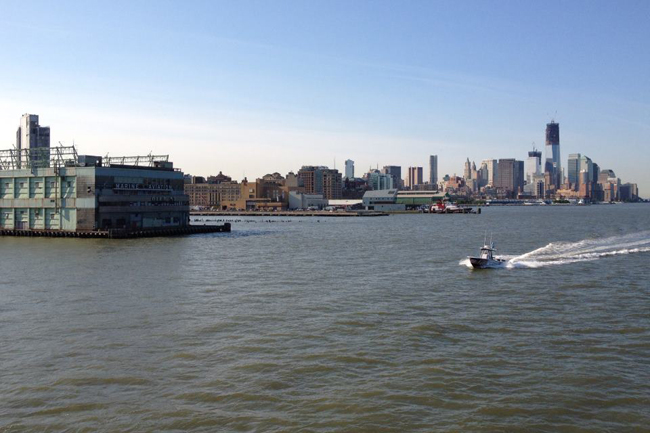NYSG Provides Educational Materials on Rip Currents, Severe Storms, and More
New York, NY, July 9, 2012 - New York Sea Grant (NYSG) will be in attendance this Saturday at the Metropolitan Waterfront Alliance's (MWA) 5th annual City of Water Day. Up to 20,000 on Governors Island and another 5,000 people in Liberty State Park are expected to participate. Last year, 25,000 people took part in the festival, while millions of others across the region heard the City of Water Day message through extensive media coverage.
"The City of Water Day Festival is a unique and high-profile free annual event that focuses wide-scale public attention on the challenges and solutions facing our waterfront," says Cortney Worrall, MWA's Chief Operating Officer. Worrall is also a member of New York Sea Grant's Program Advisory Council, whose members provide input on the program's Strategic Planning process and funded research.
Ferries will run ferry between Governors Island and Liberty State Park on Saturday so that people can enjoy all the activities. In addition to a waterfront activity fair (where New York Sea Grant will have a table), there are free boat tours as well as opportunities to kayak, row and fish.
Some of NYSG's offerings available at the event include a new fact sheet highlighting the program's efforts in and around the New York City region (
pdf). NYSG will also provide attendees with information on avoiding getting caught in rip currents, narrow channels of fast-moving water that can pull swimmers away from the shore. Rip currents account for over 80% of rescues performed by surf beach lifeguards and the United States Lifesaving Association estimates that the annual number of deaths from these deadly currents exceeds 100. For more, see
www.nyseagrant.org/ripcurrents.
Another concern this season is hurricanes, though the National Oceanic and Atmospheric Administration (NOAA) forecasters predict we'll see a near-normal 2012 Atlantic hurricane season. NYSG and other Sea Grant programs, along with NOAA and the Federal Emergency Management Agency (FEMA), encourage the public to be prepared for these and other severe storms, which in and around the New York City area raises its own set of concerns.
“2-3 million people in the outer boroughs of southern Brooklyn and Queens are at risk for flooding due to storm surge, with little chance for escape,” says Stony Brook University (SBU) Oceanography professor and storm surge expert Malcolm Bowman.
Bowman, located at SBU’s School of Marine & Atmospheric Sciences, is also a member of The Stony Brook Storm Surge Research Group, which has been funded principally by New York Sea Grant (NYSG) since 2002 to work on storm surge science, coastal defense systems and policy issues related to regional protection of New York City and Long Island.
For more on NYSG's storm surge research, see the April 2012 related news item on
severe weather preparedness. Also, NYSG provides resources on hurricane education at
www.nyseagrant.org/hurricane. And, for more on NYSG research, extension and education efforts in and around New York City, see
www.nyseagrant.org/nyc.
For more details on the City of Water Days event, visit
www.cityofwaterday.org or
MWA's Web site.
Positioned at the confluence of the Hudson River and many smaller rivers
such as the East, Hackensack, and Raritan, the New York-New Jersey
Estuary opens into the New York Bight and Long Island Sound. One of the
main focus areas in the New York City region for New York Sea Grant
research, extension and education efforts is the
Hudson River.
Long Island Sound is another main focus area for
Sea Grant, via a partnership with the Environmental Protection Agency's
Long Island Sound Study.
New York Sea Grant (NYSG), a cooperative program of Cornell University
and the State University of New York, is one of 32 university-based
programs under the National Sea Grant College Program (NSGCP) of the
National Oceanic and Atmospheric Administration (NOAA). The NSGCP
engages this network of the nation’s top universities in conducting
scientific research, education, training and extension projects designed
to foster science-based decisions about the use and conservation of our
aquatic resources. Through its statewide network of integrated
services, NYSG has been promoting coastal vitality, environmental
sustainability, and citizen awareness about the State’s marine and Great
Lakes resources since 1971.

Many water bodies connect in with the Hudson River estuary in the New York City area, including the East River, Long Island Sound, Newark Bay, New York Bay, New York Bay (whose upper and lower portions are separated from by the Verrazano Narrows strait), Jamaica Bay, and the Atlantic Ocean.
In a New York Sea Grant-funded research project, College of Staten Island investigator Dr. William G. Wallace examined how metals move up the food chain and effect aquatic predator and prey species. Cadmium, copper, lead, mercury, nickel, silver, zinc: all are metals that have a place in our industrialized world. But they also can be toxic to the living things of our air, land and sea … particularly when they occur in concentrations typical of urban environments like New York City.
Photo by Paul C. Focazio, NYSG